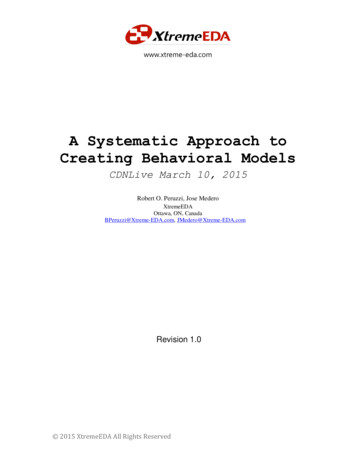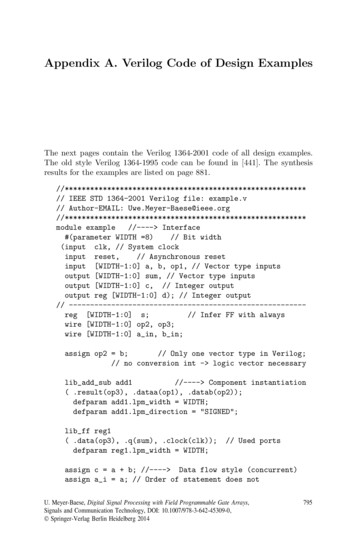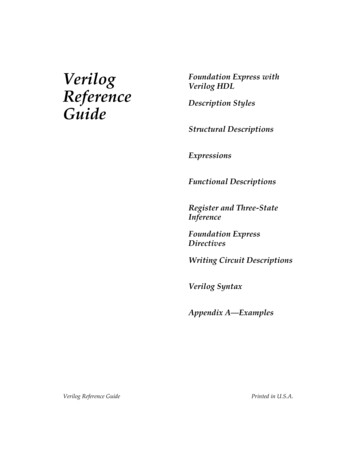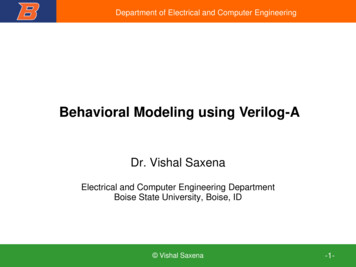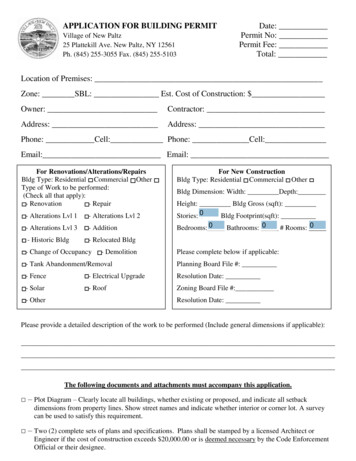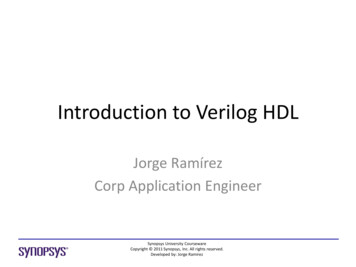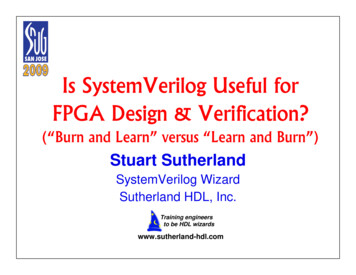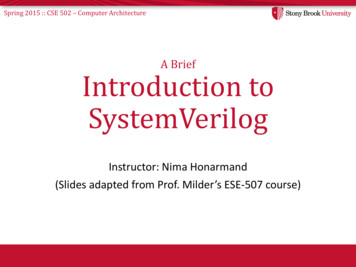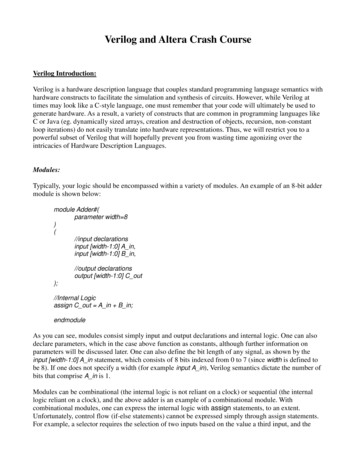
Transcription
EGC220Digital Logic FundamentalsDesign Using VerilogBaback IzadiDivision of Engineering Programsbai@engr.newpaltz.edu
Lexical ConventionBasic Verilog Lexical convention are close to C . Comment // to the end of the line. /* to */ across several lines Keywords are lower case letter & it is case sensitive VERILOG uses 4 valued logic: 0, 1, x and z Comments: // Verilog code for AND-OR-INVERT gatemodule module name ( module terminal list ); module terminal definitions functionality of module endmoduleSUNY – New PaltzElect. & Comp. Eng.
Taste of VerilogModule nameModule portsmodule Add half ( sum, c out, a, b );inputa, b;Declaration of portoutput sum, c out;modesc out bar;wirexor (sum, a, b);// xor G1(sum, a, b);nand (c out bar, a, b);not (c out, c out bar);endmoduleVerilog keywordsSUNY – New PaltzElect. & Comp. Eng.Declaration of internalsignalInstantiation of primitivegatesabG1sumc out barc out
Lexical Convention Numbers are specified in thetraditional form or below .Example : size base format number 347 -- decimal numberSize: contains decimal digitals 4’b101 -- 4- bit 01012that specify the size of the 2’o12 -- 2-bit octal numberconstant in the number of bits. 5’h87f7 -- 5-digit 87F716Base format: is the single 2’d83 -- 2-digit decimalcharacter ‘ followed by one of String in double quotesthe following characters“ this is a ).Number: legal digital.SUNY – New PaltzElect. & Comp. Eng.
Three Modeling Styles in Verilog Structural modeling (Gate-level) Use predefined or user-defined primitive gates. Dataflow modeling Use assignment statements (assign) Behavioral modeling Use procedural assignment statements (always)SUNY – New PaltzElect. & Comp. Eng.
Structural Verilog Description of Two-BitGreater-Than CircuitSUNY – New PaltzElect. & Comp. Eng.
Dissection Module and Port declarations Verilog-2001 syntax module AOI (input A, B, C, D, output F); Verilog-1995 syntaxmodule AOI (A, B, C, D, F);input A, B, C, D;output F; Wires: Continuous assignment to an internal signalSUNY – New PaltzElect. & Comp. Eng.
A Simple Dataflow Design// Verilog code for AND-OR-INVERT gatemodule AOI (input A, B, C, D, output F);wire F; // the defaultwire AB, CD, O; // necessaryassign AB A & B;assign CD C & D;assign O AB CD;assign F O;endmodule// end of Verilog codeSUNY – New PaltzElect. & Comp. Eng.Continuous Assignments
A Simple Dataflow Design// Verilog code for AND-OR-INVERT gatemodule AOI (input A, B, C, D, output F);assign F ((A & B) (C & D));endmodule// end of Verilog code‘&’ for AND, ‘ ’ for OR, ‘ ’ for XOR ‘ ’ for XNOR, ‘& ’ for NANDSUNY – New PaltzElect. & Comp. Eng.
Dataflow Verilog Description of Two-BitGreater-Than ComparatorSUNY – New PaltzElect. & Comp. Eng.
Conditional Dataflow Verilog Descriptionof Two-Bit Greater-Than CircuitSUNY – New PaltzElect. & Comp. Eng.
Verilog Description of Two-Bit GreaterThan CircuitSUNY – New PaltzElect. & Comp. Eng.
A Design Hierarchy// Verilog code for 2-input multiplexermodule INV (input A, output F); // An inverterassign F A;endmodule Module Instances MUX 2 module contains references to module AOI (input A, B, C, D, output F);each of the lower level modules// Verilog code for 2-input multiplexermodule MUX2 (input SEL, A, B, output F);// 2:1 multiplexer// wires SELB and FB are implicit// Module instances.INV G1 (SEL, SELB);AOI G2 (SELB, A, SEL, B, FB);INV G3 (.A(FB), .F(F)); // Named mappingendmodule// end of Verilog codeSUNY – New PaltzElect. & Comp. Eng.assign F ((A & B) (C & D));endmoduleF (SEL)’. A (SEL).BSELB (SEL)’F (SELB).A (SEL).B1. Invert SEL and get SELB2. Use AOI and get F’3. Invert F’ and get F
Another Examplemodule decoder (A,B, D0,D1,D2,D3);input A,B;output D0,D1,D2,D3;assign D0 A& B;assign D1 A&B;assign D2 A& B;assign D3 A&B;endmoduleSUNY – New PaltzElect. & Comp. Eng.
Hierarchical representation of Addermodule fulladder (A,B,CIN, S,COUT);input A,B,CIN;output S,COUT;assign S A B CIN;assign COUT (A & B) (A & CIN) (B & CIN);endmoduleSUNY – New PaltzElect. & Comp. Eng.
module four bit adder (CIN, X3,X2,X1,X0,Y3,Y2,Y1,Y0, S3,S2,S1,S0,COUT);input CIN, X3, X2, X1, X0,Y3,Y2,Y1,Y0;output S3, S2, S1, S0, COUT;wireC1, C2, C3;fulladder FA0 (X0,Y0, CIN, S0, C1);fulladder FA1 (X1,Y1, C1, S1, C2);fulladder FA2 (X2,Y2, C2, S2, C3);fulladder FA3 (X3,Y3, C3, S3, COUT);endmoduleSUNY – New PaltzElect. & Comp. Eng.
module adder 4 (A, B, CIN, S ,COUT);input [3:0] A,B;input CIN;output [3:0] S;output COUT;wire [4:0] C;full adder FA0 (B(0), A(0), C(0), S(0), C(1));full adder FA1 (B(1), A(1), C(1), S(1), C(2));full adder FA2 (B(2), A(2), C(2), S(2), C(3));full adder FA3 (B(3), A(3), C(3), S(3), C(4));assign C(0) CIN;assign COUT C(4);endmoduleSUNY – New PaltzElect. & Comp. Eng.
Verilog StatementsVerilog has two basic types of statements1. Concurrent statements (combinational)(things are happening concurrently, ordering does not matter) Gate instantiations and (z, x, y), or (c, a, b), xor (S, x, y), etc. Continuous assignments assign Z x & y; c a b; S x y2.Procedural statements (sequential)(executed in the order written in the code) always @ - executed continuously when the event is active Initial - executed only once (used in simulation) if then else statementsSUNY – New PaltzElect. & Comp. Eng.
Behavioral Descriptionmodule Add half ( sum, c out, a, b );inputa, b;aoutputsum, c out;breg sum, c out;always @ ( a or b )beginsum a b;// Exclusive orc out a & b;// AndendendmoduleMust be of the‘reg’ typeSUNY – New PaltzElect. & Comp. Eng.Add halfProcedureassignmentstatementssucmoutEvent controlexpression orsensitivity list
Conditional Statement Conditional expression ? true expression : false expression;Example: Assign A (B C) ? (D 5) : (D 2); if B is less than C, the value of A will be D 5, or else A will have thevalue D 2. An if-else statement is a procedural statement.//Behavioral specificationmodule mux2to1 (w0, w1, s, F);input wo,w1,s;output F;reg F;SUNY – New PaltzElect. & Comp. Eng.always @ (w0,w1,s)if (s 1) F w1;else F w0;endmodulealways @ (w0,w1,s)F s ? w1: w2;endmodulesensitivity list
Mux 4-to-1module mux4to1 (w0, w1,w2, w3, S, F);input w0,w1,w2,w3,[1:0] S;output F;reg F;always @ (w0,w1,w2,w3,S)if (S 0) F w0;else if (S 1) F w1;else if (S 2) F w2;else F w3;endmoduleSUNY – New PaltzElect. & Comp. Eng.
Verilog OperatorNameFunctional Group greater than greaterthan or equal to lessthan less than or equaltorelational ! case equality caseinequalityequality& bit-wise AND bit-wisebit-wise bit-wiseXOR bit-wise OR&& logical AND logicalORBoolean Operators in VerilogSUNY – New PaltzElect. & Comp. Eng.logical
Another Example//Dataflow description of a 4-bit comparator.module mag comp (A,B,ALTB,AGTB,AEQB);input [3:0] A,B;output ALTB,AGTB,AEQB;assign ALTB (A B),AGTB (A B),AEQB (A B);endmoduleSUNY – New PaltzElect. & Comp. Eng.
Dataflow Modeling//Dataflow description of 4-bit addermodule binary adder (A, B, Cin, SUM, Cout);input [3:0] A,B;input Cin;output [3:0] SUM;output Cout;assign {Cout, SUM} A B Cin;endmoduleSUNY – New PaltzElect. & Comp. Eng.concatenationBinary addition
Design of an ALU using CaseStatementSFunction0Clear1B-A2A-B3A B4A XOR B5A OR B6A AND B7Set to all 1’sSUNY – New PaltzElect. & Comp. Eng.// 74381 ALUmodule alu(s, A, B, F);input [2:0] s;input [3:0] A, B;output [3:0] F;reg [3:0] F;always @(s or A or B)case (s)0: F 4'b0000;1: F B - A;2: F A - B;3: F A B;4: F A B;5: F A B;6: F A & B;7: F 4'b1111;endcaseendmodule
2 SUNY – New PaltzElect. & Comp. Eng.6// 74381 ALUmodule VALU(s, A, B, F);input [2:0] s;input [3:0] A, B;output [3:0] F;reg [3:0] F;always @(s or A or B)case (s)0: F 4'b0000;1: F B - A;2: F A - B;3: F A B;4: F A B;5: F A B;6: F A & B;7: F 4'b1111;endcaseendmodule
Blocking vs. Nonblocking Assignments Verilog supports two types of assignments within alwaysblocks, with subtly different behaviors. Blocking assignment: evaluation and assignment are immediatealways @ (a or b or c)beginx a b;y a b c;z b & c;end1. Evaluate a b, assign result to x2. Evaluate a b c, assign result to y3. Evaluate b&( c), assign result to z Nonblocking assignment: all assignments deferred until all right-handsides have been evaluated (end of simulation timestep)alwaysbeginx. y. z end@ (a or b or c)a b;a b c;b & c;1. Evaluate a b but defer assignment of x2. Evaluate a b c but defer assignment of y3. Evaluate b&( c) but defer assignment of z4. Assign x, y, and z with their new values Sometimes, as above, both produce the same result. Sometimes, not!SUNY – New PaltzElect. & Comp. Eng.
Blocking vs. Nonblocking Assignments The token represents a blocking blocking procedural assignment Evaluated and assigned in a single step Execution flow within the procedure is blocked until theassignment is completed The token represents a non-blocking assignment Evaluated and assigned in two steps:1. The right hand side is evaluated immediately2. The assignment to the left-hand side is postponed until otherevaluations in the current time step are completed//swap bytes in wordalways @(posedge clk)beginword[15:8] word[ 7:0];word[ 7:0] word[15:8];endSUNY – New PaltzElect. & Comp. Eng.//swap bytes in wordalways @(posedge clk)beginword[15:8] word[ 7:0];word[ 7:0] word[15:8];end
Why two ways of assigning values?Conceptual need for two kinds of assignment (in always blocks):axabbycBlocking:Evaluation and assignmentare immediatea bb ax a & by x cNon-Blocking:Assignment is postponed untila bx a & by x call r.h.s. evaluations are doneb aWhen to use:SequentialCircuits( only in always blocks! )SUNY – New PaltzElect. & Comp. Eng.CombinationalCircuits
Golden Rules Golden Rule 1: To synthesize combinational logic using an always block, allinputs to the design must appear in the sensitivity list. Golden Rule 2: To synthesize combinational logic using an always block, allvariables must be assigned under all conditions.SUNY – New PaltzElect. & Comp. Eng.
Golden Rulesreg f;always @ (sel, a, b)begin :if (sel 1)f a;elsef b;end Proper as intendedSUNY – New PaltzElect. & Comp. Eng.Reg f;always @ (sel, a, b)begin f b;if (sel 1)f a;endreg f;always @ (sel, a)begin :if (sel 1)f a;end Setting variablesto default valuesat the start of thealways block OK as well! What if sel 0? Keep the current value Undesired functionality Unintended latch Need to include else
Verilog NameOperator[]bit-select or partselect()parenthesis!logical negation negation&reduction AND reduction OR &reduction NAND reduction NOR reduction XOR or reduction XNOR unary (sign) plusunary (sign) minus{}concatenation{{ }} replication*multiply/divide%modulusSUNY – New PaltzElect. & Comp. icarithmeticVerilogOperator ! & && ?:Namebinary plusbinary minusshift leftshift rightgreater thangreater than or equaltoless thanless than or equal tocase equalitycase inequalitybit-wise ANDbit-wise XORbit-wise ORlogical ANDlogical alconditional
AppendixSUNY – New PaltzElect. & Comp. Eng.
Arithmetic in Verilogmodule Arithmetic (A, B,Y1,Y2,Y3,Y4,Y5);input [2:0] A, B;output [3:0] Y1;output [4:0] Y3;output [2:0] Y2,Y4,Y5;reg [3:0] Y1;reg [4:0] Y3;reg [2:0] Y2,Y4,Y5;always @(A or B)beginY1 A B;//additionY2 A-B;//subtractionY3 A*B;//multiplicationY4 A/B;//divisionY5 A%B;//modulus of A divided by BendendmoduleSUNY – New PaltzElect. & Comp. Eng.
Sign Arithmetic in Verilogmodule Sign (A, B,Y1,Y2,Y3);input [2:0] A, B;output [3:0] Y1,Y2,Y3;reg [3:0] Y1,Y2,Y3;always @(A or B)beginY1 A/-B;Y2 -A -B;Y3 A*-B;endendmoduleSUNY – New PaltzElect. & Comp. Eng.
Equality and inequality Operations in Verilogmodule Equality (A, B,Y1,Y2,Y3);input [2:0] A, B;output Y1,Y2;output [2:0] Y3;reg Y1,Y2;reg [2:0] Y3;always @(A or B)beginY1 A B;//Y1 1 if A equivalent to BY2 A! B;//Y2 1 if A not equivalent to Bif (A B)//parenthesis neededY3 A;elseY3 B;endendmoduleSUNY – New PaltzElect. & Comp. Eng.
Logical Operations in Verilogmodule Logical (A, B, C, D, E, F,Y);input [2:0] A, B, C, D, E, F;output Y;reg Y;always @(A or B or C or D or E or F)beginif ((A B) && ((C D) !(E F)))Y 1;elseY 0;endendmoduleSUNY – New PaltzElect. & Comp. Eng.
Bit-wise Operations in Verilogmodule Bitwise (A, B,Y);input [6:0] A;input [5:0] B;output [6:0] Y;reg [6:0] Y;always @(A or B)beginY[0] A[0]&B[0]; //binary ANDY[1] A[1] B[1]; //binary ORY[2] !(A[2]&B[2]); //negated ANDY[3] !(A[3] B[3]); //negated ORY[4] A[4] B[4]; //binary XORY[5] A[5] B[5]; //binary XNORY[6] !A[6]; //unary negationendendmoduleSUNY – New PaltzElect. & Comp. Eng.
. Concatenation and Replication in Verilog The concatenation operator "{ , }" combines (concatenates) the bitsof two or more data objects. The objects may be scalar (single bit) orvectored (multiple bit). Multiple concatenations may be performedwith a constant prefix and is known as replication.module Concatenation (A, B,Y);input [2:0] A, B;output [14:0] Y;parameter C 3'b011;reg [14:0] Y;always @(A or B)beginY {A, B, {2{C}}, 3'b110};endendmoduleSUNY – New PaltzElect. & Comp. Eng.
Shift Operations in Verilogmodule Shift (A,Y1,Y2);input [7:0] A;output [7:0] Y1,Y2;parameter B 3; reg [7:0] Y1,Y2;always @(A)beginY1 A B; //logical shift leftY2 A B; //logical shift rightendendmoduleSUNY – New PaltzElect. & Comp. Eng.
Conditional Operations in Verilogmodule Conditional (Time,Y);input [2:0] Time;output [2:0] Y;reg [2:0] Y;parameter Zero 3b'000;parameter TimeOut 3b'110;always @(Time)beginY (Time! TimeOut) ? Time 1 : Zero;endendmoduleSUNY – New PaltzElect. & Comp. Eng.
Reduction Operations in Verilogmodule Reduction (A,Y1,Y2,Y3,Y4,Y5,Y6);input [3:0] A;output Y1,Y2,Y3,Y4,Y5,Y6;reg Y1,Y2,Y3,Y4,Y5,Y6;always @(A)beginY1 &A; //reduction ANDY2 A; //reduction ORY3 &A; //reduction NANDY4 A; //reduction NORY5 A; //reduction XORY6 A; //reduction XNORendendmoduleSUNY – New PaltzElect. & Comp. Eng.
SUNY – New PaltzElect. & Comp. Eng.
Testbench for the Structural Model of theTwo-Bit Greater-Than ComparatorSUNY – New PaltzElect. & Comp. Eng.
Propagation Delay for an InverterSUNY – New PaltzElect. & Comp. Eng.
Circuit to demonstrate an HDL (Verilog)Module smpl Circuit (A, B, C, D, E)input A, B, C;output D, E;wire w1;and # (30) G1 (w1, A, B);not #10 G2 (E, C);or #(20) G3 (D, w1, E);endmoduleSUNY – New PaltzElect. & Comp. Eng.
Interaction between stimulusand design modulesSUNY – New PaltzElect. & Comp. Eng.
SUNY -New Paltz Elect. & Comp. Eng. Basic Verilog Lexical Convention Lexical convention are close to C . Comment // to the end of the line. /* to */ across several lines Keywords are lower case letter & it is case sensitive VERILOG uses 4 valued logic: 0, 1, x and z Comments: // Verilog code for AND-OR-INVERT gate module module_name ( module_terminal_list );
